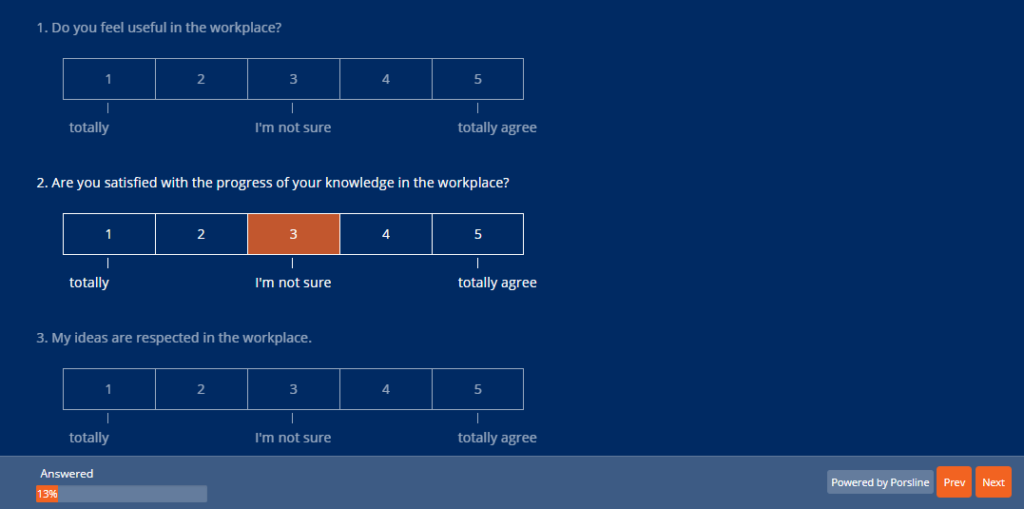How do you create an effective employee survey?

If you are reading this, then you believe that employee surveys produce many positive results for your business. However, many of the human resources managers and experts indeed ignore the achievements in the ways of designing surveys and evaluating employees. As a result, no useful information is obtained from workplace and employee evaluation surveys. What do you think the difference is between a useful employee survey and a useless survey? The difference lies in designing and implementing them accurately and thoughtfully. If we disregard those human resource managers who think they are responsible only for administrative and employment processors, we see that many other human resource managers and activists still adopt the principles of 40-50 years ago in human resource surveys.
You can now learn 10 principles of human resource survey improvement. These principles are classified into four categories: content, writing, measurement scale, and survey implementation method.
Principle guidelines to employee survey and questionnaire content
1) Replace questions on employee motives and views with questions on observable behavior. Many of the performance evaluation or managerial leadership style evaluation questionnaires ask about the attributes of ideas of respondents. For instance, they are asked, “How much do you think your manager or supervisor knows business and market?” The answer to this question can easily be undermined by managers’ reasoning that respondents are unable to know the business well enough to comment on it.
Therefore, you should focus your question on specific and observable behavior and ask respondents to express their experiences accordingly. For example, you can ask, “How successful do you think your manager/supervisor has been successful in dealing quickly with issues raised by customers?” Although this question is still slightly subjective, the answers can be interpreted and compared with the actual performance results.
2) The questionnaire should include specific items, to which the responses can independently be verified. If there is no correlation between questionnaire responses and useful facts, the questionnaire validity is doubted. For instance, you can ask in a 360-degree feedback questionnaire, “To what extent does your manager/supervisor form loyal and sustainable work relationships with team members and employees?” The results of this question are comparable to the actual employee retention or departure rate at that work unit. Therefore, the questionnaire’s reliability and validity can be guaranteed.
3) Measure only the behavior having a clear correlation with organizational performance.
Although it may appear obvious, three-fourths of common items have no clear correlation with occupational performance and business outputs on employee surveys and questionnaires. This is one of the reasons for the unwillingness of senior managers to conduct human resources surveys regularly, consistently, and systematically.
Thus, ask the stakeholders to state the future problems and their causes. People can express fundamental challenges very well; however, they might be doubtful about their causes and solutions. For instance, assume that the low quality of support services is a crucial problem; however, there is doubt about its origin, i.e., sharing no knowledge between support experts. In the employee survey, you can ask support employees, “How much do they access the knowledge required to solve customer problems?” The results show whether weakness in sharing knowledge has been the leading cause of low quality of support services.
Principle guidelines to employee survey and questionnaire writing
4) Avoid integrating two separate subjects into one item. Two relevant subjects might be integrated into many of the questionnaire items to prevent a large number of items. However, incorporating two separate elements can cause problems. Consider this question, “How do you evaluate a manager’s skill in recruitment and employee reward determination?” On what ground can the results of this question be used to come up with an accurate analysis? Recruitment or reward determination? These two concepts are separated and irrelevant.
To decide whether to integrate two subjects into one question, you can ask yourself if a similar corrective action or intervention is required to modify the relevant behavior addressed by each item. You can ask, “Does the manager provide constructive feedback and shows an appropriate reaction to feedback collection?” Receiving and providing feedback would require flexibility and enthusiasm for learning as well as similar views and talents. However, recruitment and reward determination are different.
5) Write one-third of the questions in a way that their appropriate responses would be negative. Agreement bias is a common type of bias among questionnaire respondents. It has already been covered in A Questionnaire Should Also Be Able to Say NO! The best way of preventing this type of bias is to write the items in a way that their appropriate responses would be negative. For instance, you can write, “Conflicts and contradictions are not solved well in our department” instead of “Conflicts and contradictions are solved well in our department” on a Likert-scale. It is necessary to point out different writing styles of questions to avoid making mistakes and drawing the attention of respondents.

Principle guidelines to employee survey and survey measurement scale
6) In scale items, it is better to use numbers on the scale and labels at the beginning and end of a level. In these items, numbers are more expressive than words. In Likert-scale questions which are commonly used in personnel performance evaluation questionnaires, you should label the beginning and end of a scale with terms and let respondents see the numbers to make better decisions and respond to items accordingly.

7) Use graded items properly instead of scale items. Assume that a personnel performance evaluation questionnaire includes this scale question, “I am committed to the quality of outputs in performing my tasks.” The responses can range from totally disagree to agree. According to research results, responses are mostly biased to agree on such questions. Now imagine you use a graded item instead of a scale item and ask, “In what percentage of cases have you complied with the quality of work outputs?” In this case, responses will be closer to a standard figure. The use of estimation, percentage, and grading can improve the quality of data in such cases.
8) Avoid changing the measurement scale in questionnaire items. Using a measurement scale such as a 1-5 scale in all items can improve the response time, provide a higher quality of data, and simplify the quantitative comparison between different parameters.
Principle guidelines to the employee survey implementation
9) Employees should respond to the questionnaire items anonymously. Employees prefer to provide feedback on the workplace and human resources survey anonymously. In other words, they prefer that organizations be unable to determine which response has been submitted by whom. Therefore, many of the organizations employ extra-organizational software systems to save information on extra-organizational servers. As a result, employees can feel more comfortable when they participate in a survey.
10) In large enterprises, employee survey information should be analyzed at the work level. In addition to keeping respondents anonymous, an organization should be able to explain the collected data at work units, each of which should be able to analyze its specific analytic report. Finally, the employee survey and questionnaire response time, like any other typical survey of marketing and customer research, should not exceed 15-20 minutes.
Porsline provides you with special features to conduct employee surveys anonymously and generate special forms of each work unit.
Low-quality data and misinformation lead to false decisions and imposes additional expenses on the organization. Therefore, these ten principles can help you design a useful employee survey and make the results tangible for all managers and employees quickly.




